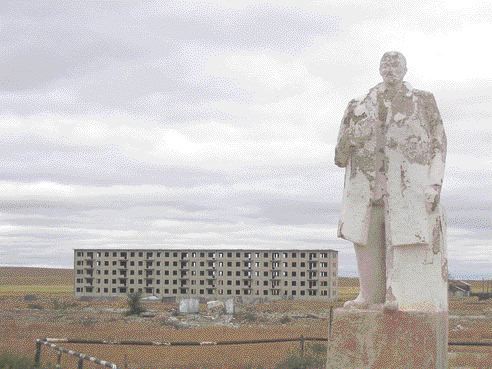Vancouver —
When the Soviet empire exhausted its eastern European uranium supplies in the early 1970s, the hunt for a new source of the highly strategic metal took on a frantic pace. At the height of the Cold War, the Russian effort included wide-scale radiometric surveys over all available territory, with some of the best anomalies and targets being identified in remote northeastern Mongolia.
The drive to secure a significant, stable source of fuel for nuclear reactors and weapons sparked the deployment of tens of thousands of Russian troops and support personnel into the cities of Mardhai and Choibalsan to fast-track exploration and development of the newly discovered deposits. The project area is situated near the triple-junction border of Mongolia, Russia and China.
The scale of exploration and infrastructure was truly mind-boggling: From the mid-1970s to early 1990s, numerous drill fences covered hundreds of kilometres over the Saddle Hills area, identifying several major targets. More than 15,000 surface drill holes and extensive underground development was conducted on the deposits, facilitating infill drilling and bulk sampling.
Initial production, from the Dornod open pit, began in 1988 with the uranium-bearing ore loaded onto rail and hauled north to a Siberian milling facility. Between 1988-1995, recorded production from the Dornod 2 open-pit deposit was just over 700,000 tonnes of ore grading 0.12% U3O8. Meanwhile, underground development advanced on other area deposits, primarily Gurvanbulag, and included large, multi-compartment, concrete-lined shafts up to 600 metres deep and lateral workings that stretched many kilometres.
Although little remains of the Russian surface workings, infrastructure and towns, the cost most likely exceeded US$1 billion in current dollars.
Historic Russian resource calculations, conducted from 1982-1989, covered the five main deposit areas (Gurvanbulag, Mardaigol, Khavar, Dornod blocks and Ulaan). The study reviewed an aggregate resource of 4.3 million tonnes grading 0.245% U3O8 (about 23 million contained pounds of U3O8) classified as C1 category mineralization (comparable to modern inferred resources). The C1 resource is almost exclusively contained in the Gurvanbulag deposit. An additional 10.7 million tonnes of mineralization grading 0.14% U3O8 was classified as C2 (not comparable to a modern resource standard without verification drilling). None of the Russian calculations are compliant with National Instrument 43-101 standards.
Enter Western Prospector Group (WNP), which in late 2004, acquired exploration licences covering essentially the entire uranium district, except for a small portion (the Dornod deposit) at the eastern end, held by soon-to-be-listed
Uranium mineralization occurs mainly as stratabound lenses in the lower part of a Mesozoic sedimentary sequence grading, stratigraphically upwards, into volcanics within the Saddle Hills basin, all overlying a late-Proterozoic to Paleozoic basement of gneisses, schist and granites. Additional mineralization occurs as structurally controlled, steeply dipping to vertical zones possibly connecting with the stratabound zones. At the flagship Gurvanbulag deposit, uranium occurs as fracture coating yellow uranophane and fracture, vein and disseminated black pitchblende or coffinite. The area is now recognized as a significant new uranium district.
WNP has initiated an aggressive drill program on the Gurvanbulag deposit, observed during a recent site visit by The Northern Miner, aimed at providing enough data for an updated, measured and indicated resource calculation.
WNP’s first three holes on Gurvanbulag intersected significant intervals of uranium mineralization, including:
– Hole 5001 — targeting the northwest updip portion of the deposit, drilling returned 2.2 metres (from 186 metres down-hole depth) grading 0.21% U3O8;
– Hole 5002 — positioned 250 metres east of hole 5001, drilling returned 2.8 metres (from 252 metres down-hole) averaging 0.29% U3O8, including 2.2 metres of 0.35% U3O8 in the Gurvanbulag zone just above the 200-metre level underground workings; and
– Hole 5003 — targeting a reported low-grade zone at the 200-metre level, N-core drilling cut 6.8 metres (from 310 metres down-hole) of 0.57% U3O8, including a high-grade interval of 3.3 metres averaging 0.98% U3O8.
The second batch of holes in WNP’s verification drilling delivered even higher-grade values. Hole 5006 returned a 7.1-metre intersection (from 270 metres depth) grading 2.1% U3O8, including 4 metres of 3.7% U3O8 and a 1-metre intercept grading 8.1% U3O8.
Beyond its drilling programs, WNP has also constructed a water impoundment-settling pond for planned dewatering of the Gurvanbulag shaft in spring 2006. Underground examination of the partially flooded concrete-lined shaft revealed it to be in very good condition, potentially providing the company the advantage of saving at least a year of construction and tens of millions of dollars should the project advance to production. In addition, a headframe sourced from
The company currently has three drill rigs active and has completed more than half of this year’s planned 100 holes.
WNP’s ongoing work at Saddle Hills is no doubt being closely watched by some of the other advanced uranium explorers now active in Mongolia, including
Recently, the company also bolstered its treasury by closing a $20.8 million “bought deal” private placement financing underwritten by National Bank Financial and Haywood Securities. WNP sold 4 million shares issued at $5.20 apiece with funds earmarked for accelerating work programs at Saddle Hills towards development. The company’s cash working capital position stood at about $40 million following the financing.
With the latest uranium spot price at US$33.95 per lb. U3O8, WNP investors have seen significant gains. The stock has rallied from its annual low of about $1.00 to a high of $6.20 following the recent high-grade results. Based on its 38.9 million shares outstanding, Western Prospector posts a market capitalization of about $190 million based on its recent $4.85-per-share trading price.


Be the first to comment on "Western Prospector builds on Soviet-era uranium project"